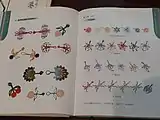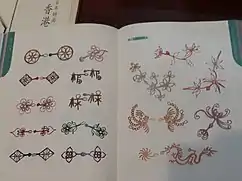Frog (fastening)
Pankou (simplified Chinese: 盘扣; traditional Chinese: 盤扣; pinyin: pánkòu), also called huaniu (Chinese: 花纽; pinyin: Huāniǔ; lit. 'flower buttons') or panhuaniu (Chinese: 盘花纽) in China, are referred as pankou knots, Chinese frog closures and decorative toggles in English language,[1][2][3] is a type of ornamental braiding closure made out of cord, consisting of a button (oftentimes a Chinese button knot for a traditional oriental style[4]: 76 ) and a loop; it is used to fasten garments without creating an overlap.[5]: 40 Its purpose is to act as a fastener as well as providing a decorative closure for the garment.[5]: 40 It is especially used on the cheongsam, where the pankou represents the cultural essence of the dress.[6] This form of decorative fastener originated from China and was later introduced to other countries outside of China where they are now called frog closures,[4]: 76 frogs,[5]: 40 and frogging in English-speaking countries.[7]: 253 It was first adopted in the military uniform of Western countries, where they gained popularity, before eventually making its way into civilian clothes of both genders, such as overcoats, spencers, and pelisses.[5]: 40 Frog fasteners are usual to garments of Asian design, such as a shirt or coat with a mandarin collar, which features frog fasteners at the shoulder and down the front of the garment. In the design of a garment, frogging is the use of braided, frog fasteners is a detail of the overall design of the garment.
| Type | Fastening made of fabric |
|---|---|
| Material | Diverse, including silk |
| Place of origin | At least the Song dynasty (960–1279 AD), China |
| Introduced | Rest of Asia, Europe, and America |
| Pankou | |||||||
|---|---|---|---|---|---|---|---|
 | |||||||
| Chinese name | |||||||
| Traditional Chinese | 盘扣 | ||||||
| Simplified Chinese | 盤扣 | ||||||
| |||||||
| Huaniu | |||||||
| Chinese | 花纽 | ||||||
| Literal meaning | Flower buttons | ||||||
| |||||||
| Panhuaniu | |||||||
| Chinese | 盘花纽 | ||||||
| |||||||
| English name | |||||||
| English | Frogs/ Frog closures/ Frogging/ Decorative toggles | ||||||
Terminology
The English term frogging can be defined as an ornamental closures which are made of braid and cording.[7]: 253
China
Origins
The frog closures originated in China, where it is known as pankou,[3] huaniu, or panhuaniu.[1][2] The pankou is actually the end-product of thousands years of traditional Chinese knotting craft, which is itself rooted in the Lào zi culture.[1][8] As a form of fastener, the pankou first appeared on Traditional Chinese clothing,[5][9] and can be traced back to the Song dynasty when fabric was braided into braid buckles to create the loop and the button knot.[10]
Ming dynasty – Important period of development
The braided buckles of the Song dynasty continued to be used in the Yuan dynasty.[10] However, in the Ming dynasty, interlocking buckles known as zimukou (Chinese: 子母扣; lit. 'child mother button'),[11] which could be made out of gold and silver, first appeared and came in various shapes and styles.[10] The zimukou also became one of the favourite fashion accessory items of the Ming dynasty Chinese women.[10]
These interlocking buckles were not only functional as garments fasteners or as garment ornaments; they also expressed and symbolized the wishes and inspirations of its wearer, such as the longing of a better life; the wishes for a sweet and loving marital relationship through the theme of butterflies and flower (Chinese: 蝶采花); the wishes for a rich and wealthy life with the use of double silver ingots (Chinese: 双银锭), and to express wishes for a long and healthy life with the theme of "Furong Flowers and Shou" (Chinese: 芙蓉捧寿), which uses Furong flowers and the Chinese character shou《壽》, as it is a homonym for the Chinese characters fushou《福壽》which can literally be translated as "prosperity and longevity".[10]
The development of the zimukou of the Ming dynasty had a significant impact on the history of Chinese fashion as they did not only laid the foundation of the subsequent usage of a large number and variety of pankou but also led to the emergence and the popularity of the Chinese high-standing collar (and its derivative, the Mandarin collar) along with a variety of duijin yi (upper garment with central front closure) which uses the pankou on the front over the succeeding centuries.[10]
The pankou, like its Ming dynasty predecessor, the zimukou, also come in all kind of styles and shapes and continue to retain traditional Chinese designs and cultural meanings rooted deeply in traditional Chinese culture; these designs include auspicious symbols, such as pomegranates which is represent fertility and the Chinese character shou《壽》).[1]
Usage in Chinese garment
The pankou are now key elements in cheongsam representing its "soul" and provide a distinctive Chinese character to the dress;[1] they are typically sewed at the centre of the mandarin collar and along the diagonal slanted (S-shaped) opening.[3] They are also used in other garments, such as tangzhuang, gua (jacket) including those used in the qungua, and the changshan, etc.
Design and construction
The pankou is composed of a Chinese button knot is perceived as the male while its pair with the loop is considered as being the female.[1]
The pankou, which are used in the making of the cheongsam, are typically made out of silk or are made from the same materials as the dress.[3] To create more elaborate shapes of buttons, a method called wiring is used to create the desired shape.[3]
Types of pankou
There are different types of pankou which differ in shapes and elaboration:[3]
| Name | Chinese name | Description |
|---|---|---|
| Straight pankou | Zhipakou (simplified Chinese: 直盘扣; traditional Chinese: 直盤扣; pinyin: zhípánkòu); also called zikou (Chinese: 字扣; Chinese: zìkòu) | The simplest and most common form of pankou consisting of a knot of one side and a loop on the other side. |
| Floral pankou | Panhuapankou (simplified Chinese: 襻花盘扣; traditional Chinese: 襻花盤扣; pinyin: pànhuāpánkòu) | A generic term for any forms of pankou which are more elaborate than the straight pankou. |
The floral pankou can further be divided into other categories based on its shape:
| Name | Chinese name | Description | Images |
|---|---|---|---|
| Butterfly pankou | Hudiekou (Chinese: 蝴蝶扣; pinyin: húdiékòu) | A type of floral pankou which is butterfly in shape | |
| Kumquat pankou | Pipakou (Chinese: 琵琶扣; pinyin: pípákòu) | A type of floral pankou which is kumquat-shaped | |
| Phoenix tail pankou | A popular form of pankou used on Traditional Chinese wedding dress |
Influences and derivatives
Military uniforms

Europe
With the wide-reaching campaigns of Napoleon, the French military was often the first people to contact different cultures and styles. After having observing the use of frog closures in the East, they were adopted by the French Military[5]: 40
Frogs and frogging became an important decorative feature on military uniforms from the 17th–19th centuries. This was particularly evident for prestigious regiments, especially cavalry or hussars, and gave rise to the German term for frogging in general, 'Husarentressen'. These dolman jackets were tight-fitting and dominated by extensive frogging, often in luxurious materials such as gold, silver or brass metallic cording or brocades.
The frogging was usually far more than was necessary for fastening. In some cases it even became non-functional, with a concealed opening beneath it and the original jacket opening becoming a false detail. By the later 19th century, for lower grade uniforms down to postmen, telegraph boys and hotel pages, the frogging cordage would be retained as a decoration but there would be no corresponding toggle or opening with it.
.png.webp)
United States
In the United States, the frog fasteners were adopted during the War of 1812; however when the army regulations tried to promote a less European look, it was decided that the elaborate and complex frog fasteners would be replaced with more simple cotton cord loops.[5]: 40
Handmade Craftsmanship
The pankou used in the Beijing-style cheongsam are typically handmade by skilled artisans; the process of their making is complex and can take up several days of work.[6] It can typically take up to 26 procedures for the silk to be turned into eligible strips of fabric which can then be turned into the fastening.[6] These procedures include brushing silk four times with a paste to harden it, as well as the cutting of the hardened silk into strips, the stitching of the silk strips before the wiring procedure with copper wire, and the ironing of the silk strips under high temperature as its final stage.[6]
DIY frogs outside China
Ready-made frogs are available in the market and can be purchased; however, the selection may be limited for the sewers.[4]: 76 Thus, sewers may want to make their own and customized the end product in variety of styles.[4]: 76
Braid- or cord-filled bias tubing can also be purchased or be made to either match or contrast with the colour of the main garment.[4]: 76 Frogs can be made out of self-fabric such that it is the same colour as the garment although frogs are usually chosen to be a contrasting colour to that of the garment.
Frogs can be made by looping and interlocking the cording or fabric tube into the desired design, then securing the places where the cords touch by hand-sewing. The frog is then stitched onto a garment, usually by hand. When a fabric tube is used, the fabric is cut on bias. This allows the fabric tube to remain smooth and flex easily when bent into curves.[4]: 76
References
- "Evolution and revolution: Chinese dress 1700s-1990s - Cheungsam". archive.maas.museum. Retrieved 2021-07-04.
- Metzger, Sean (2015-02-24). "La Cabine d'Essayage (The Fitting Room): Cheryl Sim". Asian Diasporic Visual Cultures and the Americas. 1 (1–2): 214–218. doi:10.1163/23523085-00101018. ISSN 2352-3077.
- "Most Beautiful Pankou Knots (Chinese Frog Closures) to Wear on a Qipao". East Meets Dress. Retrieved 2021-07-04.
- Singer (1989). 101 sewing secrets. Minnetonka, Minn.: C. DeCosse Inc. ; Chicago, Ill. : Distributed by Contemporary Books. ISBN 0-86573-249-3. OCLC 19457860.
- The Greenwood encyclopedia of clothing through world history. Vol. III. Jill Condra. Westport, Connecticut. 2008. p. 40. ISBN 978-0-313-33662-1. OCLC 156808055.
{{cite book}}: CS1 maint: others (link) - 刘冬. "The Beauty of Beijing-Style Cheongsam". China Today. Retrieved 2022-08-17.
- The Greenwood encyclopedia of clothing through world history. Vol. I. Jill Condra. Westport, Connecticut. 2008. ISBN 978-0-313-33662-1. OCLC 156808055.
{{cite book}}: CS1 maint: others (link) - "Buckle knot and Chinese knot - chinaculture". en.chinaculture.org. Retrieved 2022-07-03.
- Lee, Jaeil (2014). Technical sourcebook for designers. Camille Steen (Second ed.). New York, NY. p. 277. ISBN 978-1-60901-856-6. OCLC 847941465.
- Hao, Xiao’ang; Yin, Zhihong (2020). "Research on Design Aesthetics and Cultural Connotation of Gold and Silver Interlocking Buckle in the Ming Dynasty". Proceedings of the 4th International Conference on Art Studies: Science, Experience, Education (ICASSEE 2020). Paris, France: Atlantis Press. doi:10.2991/assehr.k.200907.030.
- "Zimu Kou - Exquisite Ming Style Hanfu Button - 2022". www.newhanfu.com. 2021-05-25. Retrieved 2022-07-03.
- "The Pankou (盘扣/盤扣): the qipao knot button « The Pankou". Retrieved 2021-07-04.
_-_Gold_metal_buttons_(zimukou).jpg.webp)
.jpg.webp)

.jpg.webp)

.jpg.webp)

.jpg.webp)





